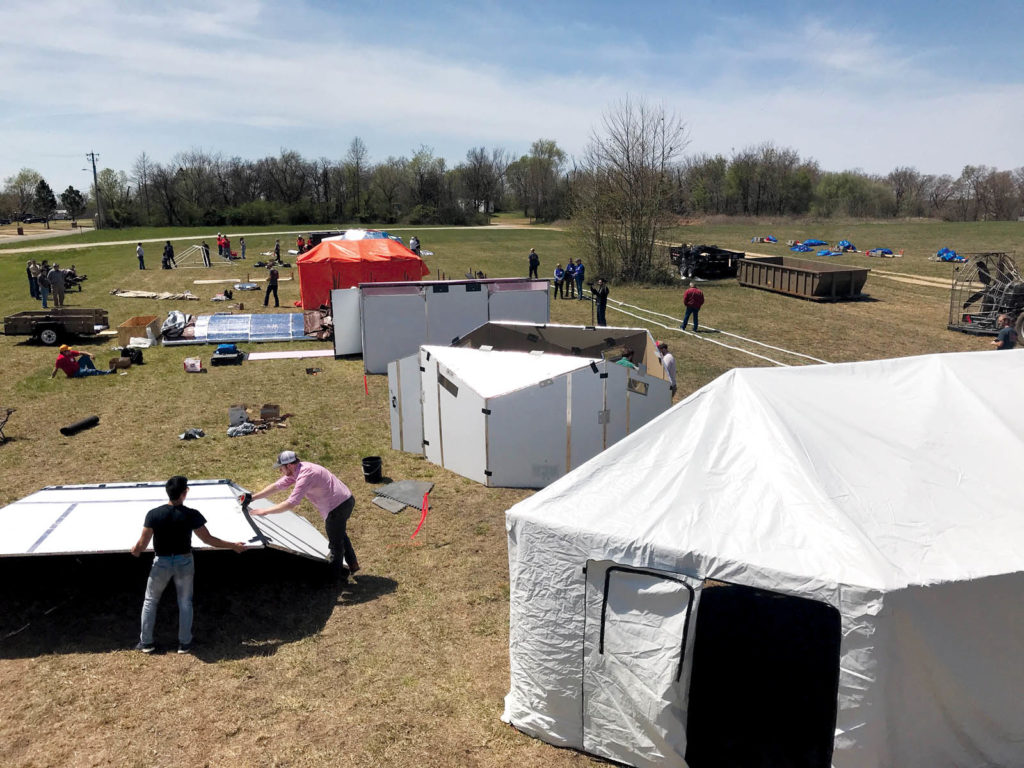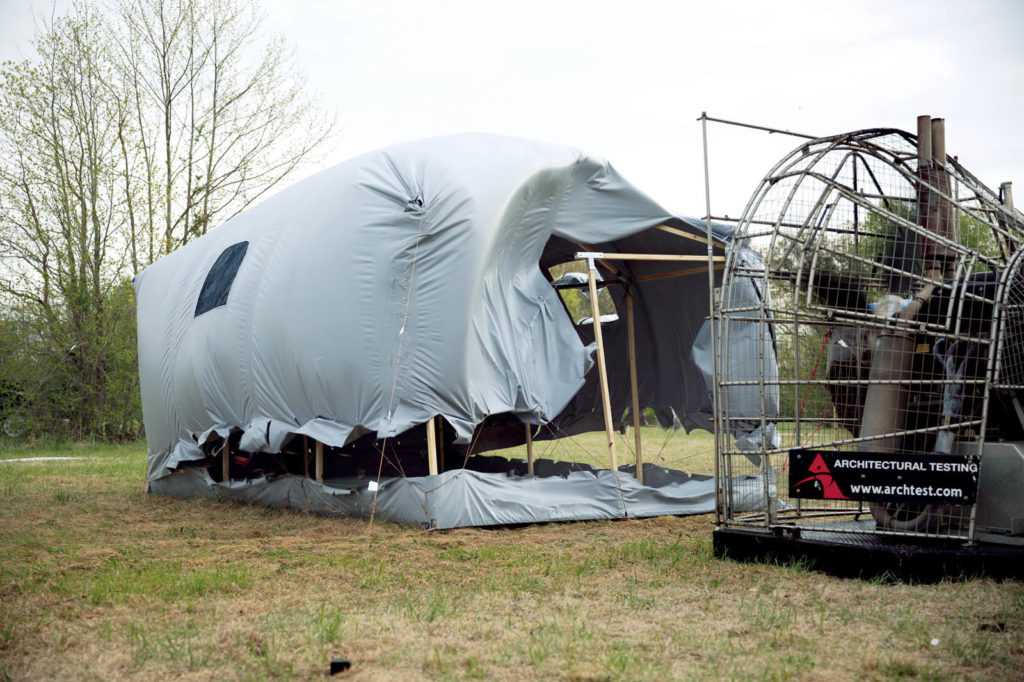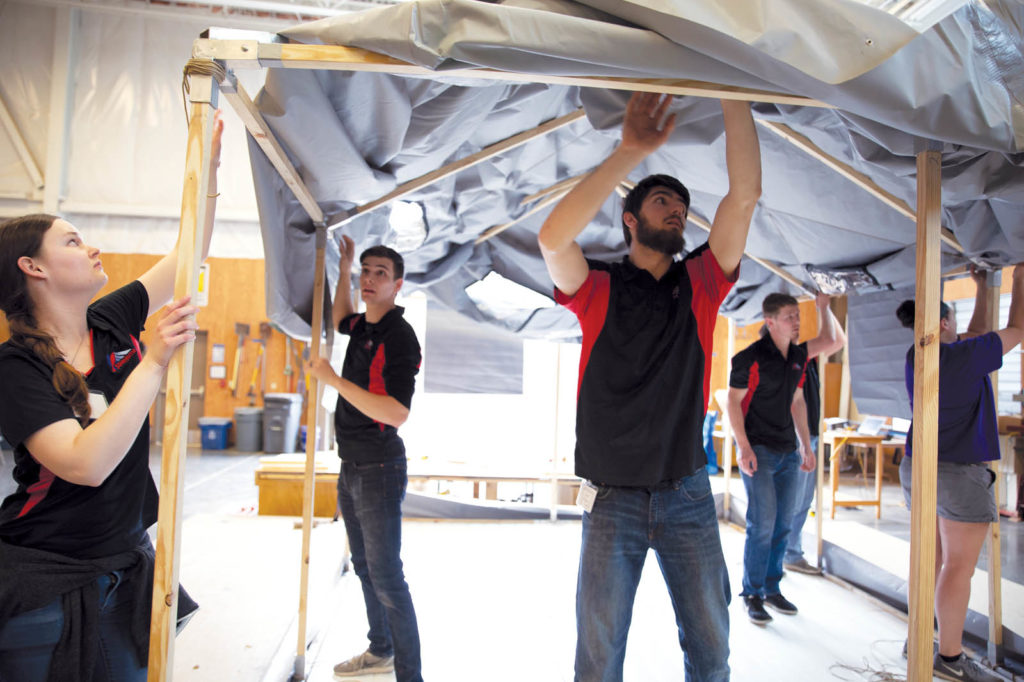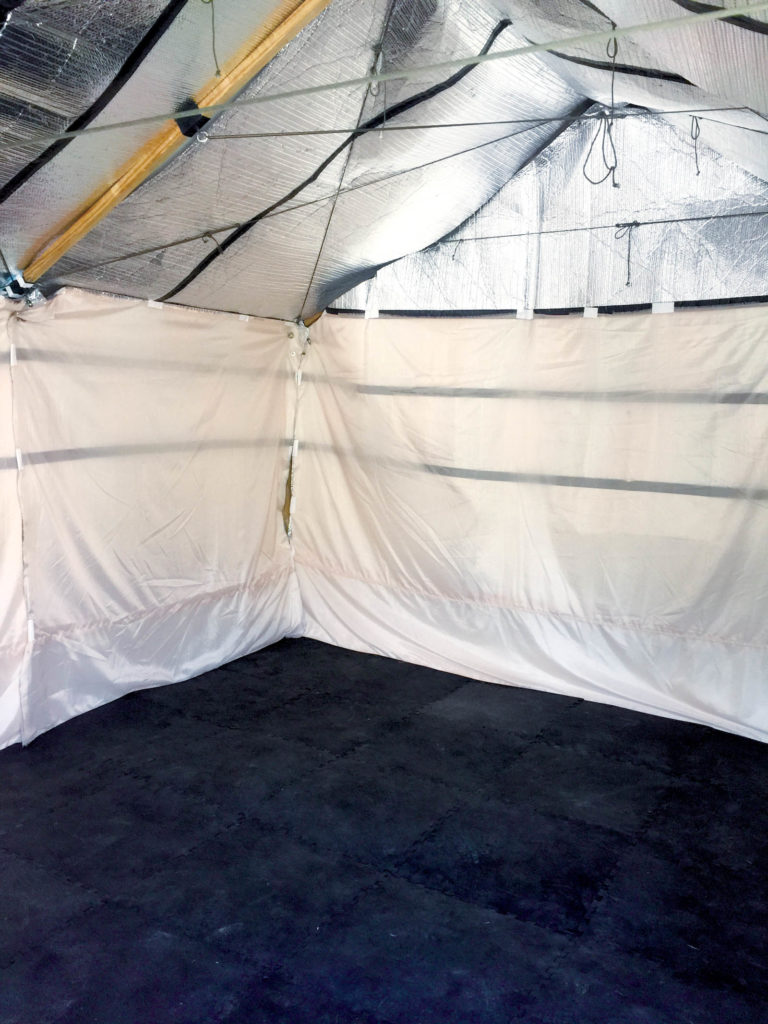John Brown University’s disaster shelter contest challenges students to develop and demonstrate solutions for emergency scenarios.
By Holly Eamon
Global economic losses from natural disasters topped $232 billion last year, rounding out a decade that cost the world nearly $3 trillion, according to the 2019 Weather, Climate & Catastrophe Insight Annual Report published by global professional services firm Aon. With both the report and the United States Geological Survey noting that increasing global surface temperatures will contribute to stronger and more frequent disasters, there will be no shortage of opportunities to serve those affected by these events.

John Brown University in Siloam Springs, Ark., connects students to these opportunities through its disaster shelter competition. Typically sponsored by a relief organization, the competition is open to students across the nation studying engineering, construction management or architecture, or participating in science or technical programs.
Teams of no more than six participants design and build a prototype of a disaster response shelter for rapid deployment and setup that aid organizations could use when responding to crises. Scenarios change every year and are based on recent real-world events, from earthquakes and hurricanes to refugees fleeing conflict. Following Sphere standards, a set of humanitarian standards that help ensure consistency among relief responders, teams must consider elements including wind, rain, privacy, security, culture, cost, ease and time to assemble, and ventilation.
“The first year of the competition we asked for ‘the perfect shelter’ but quickly realized that different events require different characteristics,” says Mark Terrill, competition coordinator and assistant professor of construction management at John Brown. “These have been in differing climates with differing cultures and needs, and this is really what makes the competition useful; students have to first assess the needs, then design and build to the requirement.”
Putting it to the test
Three weeks before the competition, teams submit a report detailing their project and its effectiveness. Ranging in length from 20 to 70 pages, the reports help the teams clarify and quantify all of the work they’ve completed in the months leading up to the competition, Terrill says. Once on-site, they present it to judges, who incorporate their presentation rating into a flexible scoring matrix that guides both students and judges through the testing process. Judges include experts from disaster response organizations, local engineers, and engineering and construction management professors.

Teams assemble their units on-site, where they are also required to demonstrate transportability. Shelters should be able to be mounted onto an existing foundation, anchored into the ground or mounted to an elevated platform made of wood or concrete. Other tests employ the use of a shake table for seismic load simulations, an industrial fan and pressure gauges for ventilation measurements, a thermal booth for insulation requirements, a rain-simulating apparatus, a light transparency test and a wind-generating machine nicknamed “the Wolf.”
The cost to manufacture their shelter is another factor students must consider and validate with receipts or a similar type of documentation. “You can develop a great emergency shelter, but if it costs $10,000 per unit, you haven’t created a probable situation for a nonprofit. It’s a trade-off we need them to acknowledge,” Terrill says.
The top three prototypes receive awards, but teams can earn additional recognition in categories such as fastest assembly, best wind resistance, best ease of handling, best ventilation, best presentation/report and best water/sewage plan.

Figuring out fabric
Regardless of the scenario, incorporating better insulation value into structures is one of the biggest challenges in not only the competition but real scenarios as well, says Eric Weaver, a past competition judge and global shelter technical advisor for Samaritan’s Purse, a Boone, N.C.-based relief organization that sponsored the past three contests. Along with ventilation and durability, this is where fabric plays a crucial role.
“Traditional tent fabric types like canvas are the go-to design, but many relief organizations are looking into using more materials with polypropylene to develop longer-lasting designs,” Weaver says.
The winning designs for the 2018 and 2019 competitions, both led by David Dittenber, chair and associate professor of civil and environmental engineering at LeTourneau University in Longview, Texas, used a fiber-reinforced vinyl. Even though the scenarios were different—the 2015 Nepal earthquake, followed by the 2017 hurricane in Barbuda—the structures were similar, with wood frames and custom-built metal end connections.
“The students found the vinyl on their own and figured out how to fabricate a custom skirt system to fit around the wood frames,” Dittenber says. “They didn’t have a lot of fabric knowledge or tools to work with, but using a little bit of cleverness and persistence, they shaped it to fit our structure without creating openings for moisture to get in.” He also credits the fabric’s strength and impermeability to their success.
“We don’t have classes on fabric, so the practical experience students receive through this competition is huge. It’s pushing them to learn about an entire new field and understand terms like warp and weft and high versus low density,” Dittenber says. “I encourage them to explore and do lots of research. They search manufacturers’ websites and call them to get samples and recommendations. There are more options than ever now, and it’s eye-opening for them to see that diversity. They get to become competent in something new and have a chance to see their ideas become a reality attached to something that has meaning.”

Making connections
Though none of the shelters have been adapted for use by an aid organization, Terrill notes that the experience of connecting classroom learning to the physical application of materials “gives a realism to the competition.”
Connecting with industry experts and organizations is another benefit. Teams typically spend downtime picking their judges’ brains about the industry or how to improve their designs. “We are educating them in a whole other world they never thought about before and helping to broaden their perspectives,” Weaver says.
These connections can also lead to internship or field positions. Even if they don’t, there’s value in building a network of contacts. A former participant recently reached out to Weaver for insight into joining an international development organization. “I just got on the phone with him for an hour and offered guidance as we talked through the options he and his wife are exploring,” says Weaver.
This participant is not alone in his desire to apply the technical skills this competition enhances to making a meaningful difference. “I’ve always had a heart for wanting to help those in need through engineering, and a lot of our students have that same mind-set and are looking for ways to use their skills in a way to serve others,” Dittenber says. “This competition helps them see how that’s possible.”
Holly Eamon is a business writer and editor based in Minneapolis, Minn.
SIDEBAR: A lesson in teamwork
John Brown University’s disaster shelter competition encourages students to consider three phases of disaster response: emergency, transitional and permanent. The main focus is transitional shelters, but to expose participants to the emergency phase, an additional mini competition challenges students to construct a livable emergency shelter in an allotted time. Each team receives a materials kit with tools such as tarps, wood, pipe and block to create a makeshift shelter tested against wind and water. “In a real rapid response scenario, it comes down to teamwork among people with different backgrounds and technical skills, so we want them to get a feel for what it’s like in the field when you’re on short notice and things don’t go according to plan,” says Eric Weaver, global shelter technical advisor for the international relief organization Samaritan’s Purse.
EDITOR’S NOTE: The Disaster Shelter Competition is usually held each year in April. Unfortunately, the 2020 competition was canceled, but John Brown University plans to resume the competition in 2021.
 TEXTILES.ORG
TEXTILES.ORG


